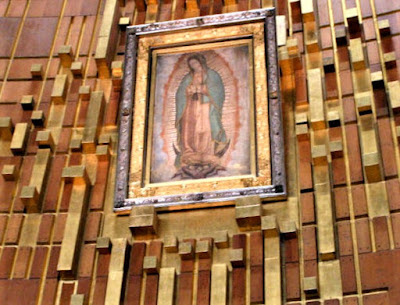At the palace, Juan once
again came before the bishop and several of his advisors. He told the bishop
his story and opened the tilma letting the flowers fall out. But it wasn't the
beautiful roses that caused the bishop and his advisors to fall to their knees;
for there, on the tilma, was a picture of the Blessed Virgin Mary precisely as
Juan had described her. The next day, after showing the Tilma at the Cathedral,
Juan took the bishop to the spot where he first met Mary. He then returned to
his village where he met his uncle who was completely cured. Since the time the tilma was
first impressed with a picture of the Mother of God, it has been subject to a
variety of environmental hazards including smoke from fires and candles, water
from floods and torrential downpours and, in 1921, a bomb which was planted by
anti-clerical forces on an altar under it. There was also a cast-iron cross
next to the tilma and when the bomb exploded, the cross was twisted out of
shape, the marble altar rail was heavily damaged and the tilma was...untouched!
Indeed, no one was injured in the Church despite the damage that occurred to a
large part of the altar structure. The feast of Our Lady of Guadalupe is celebrated on December 12.
Thursday, 9 December 2021
St Juan Diego
The image of Our Lady of
Guadalupe is one of the most treasured among Mexicans and Catholics alike. It
all started in 1531 when an Aztec Indian named Juan Diego was walking through
the Tepayac hill country in central Mexico. Near Tepayac Hill he encountered a
beautiful woman , who, speaking in his native tongue,
the beautiful lady identified herself: "My dear little son, I love you. I
desire you to know who I am. I am the ever-virgin Mary, Mother of the true God
who gives life and maintains its existence. I desire a church in this place
where your people may experience my compassion. So run now to Tenochtitlan and
tell the Bishop all that you have seen and heard." Juan, age 57, and who had never been to
Tenochtitlan, nonetheless immediately responded to Mary's request. He went to
the palace of the Bishop-elect Fray Juan de Zumarraga and requested to meet
immediately with the bishop. The bishop-elect told Juan that he would consider
the request of the Lady and told him he could visit him again if he so desired.
On Sunday, after again waiting for hours, Juan met with the bishop who, on re-hearing
his story, asked him to ask the Lady to provide a sign as a proof of who she
was. Juan dutifully returned to the hill and told Mary, who was again waiting
for him there, of the bishop's request. Mary responded: "My little son, am
I not your Mother? Do not fear. The Bishop shall have his sign. Come back to
this place tomorrow." Unfortunately, Juan was not able to return to the
hill the next day. His uncle had become mortally ill and Juan stayed with him
to care for him. After two days, with his uncle near death, Juan had to pass
Tepayac Hill to get to the priest. As he was passing, he found Mary waiting for
him. She spoke: "Do not be distressed, my littlest son. Your uncle will
not die at this time. Go to the top of the hill and cut the flowers that are
growing there. Bring them then to me." While it was freezing on the
hillside, Juan obeyed Mary's instructions and went to the top of the hill where
he found a full bloom of Castilian roses. Removing his tilma, a poncho-like
cape made of cactus fiber, he cut the roses and carried them back to Mary. She
rearranged the roses and told him: "My little son, this is the sign
I am sending to the Bishop. Tell him that with this sign I request his greatest
efforts to complete the church I desire in this place. Show these flowers to no
one else but the Bishop. This time the Bishop will believe all you tell
him."


No comments:
Post a Comment